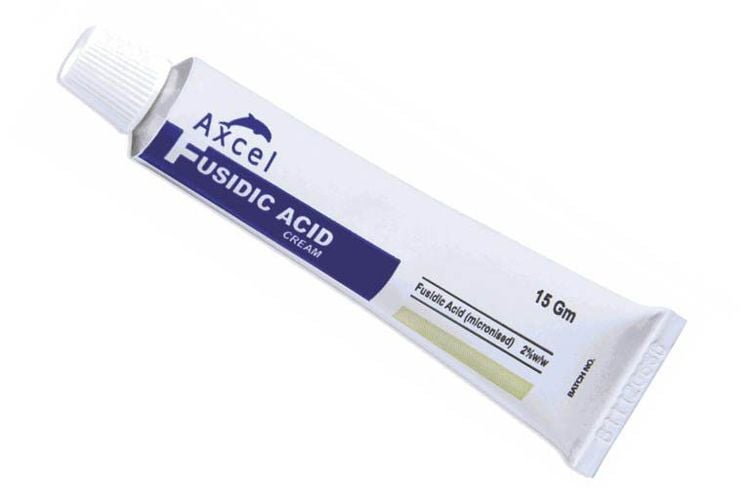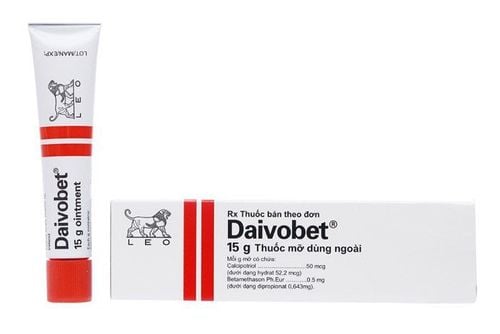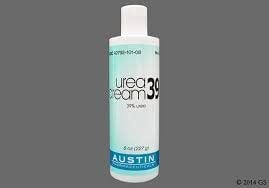This is an automatically translated article.
Fusidic acid is an antibiotic extracted from the fungus Fusidium coccineum. Fusidic acid has a good effect on acne because it is effective against gram-positive bacteria such as staphylococcus and corynebacterium.1. What is the effect of fusidic acid?
Fusidic acid is an antibiotic with both hydrophilic and lipophilic properties, so it penetrates very well into the skin, reaching the deep layers of the skin and is present in all layers of skin and subcutaneous tissue. The drug works by preventing the growth of bacteria that cause an infection. Sodium fusidate is a fusidic acid salt and works by a similar mechanism. Topical fusidic acid is suitable for superficial and deep skin infections. Fusidic acid is indicated for the treatment of skin infections caused by viral or staphylococcal infections, streptococci and other microorganisms sensitive to fusidic acid. Fusidic acid cream or sodium fusidate ointment are antibiotics that work to clear up infections on the surface of the skin quickly, especially in small areas of infection. If the skin infection is more extensive, antibiotic tablets or liquid medication may be indicated.Skin diseases often treated with topical fusidic acid such as discoid eczema, stasis eczema, seborrheic dermatitis, atopic dermatitis, contact dermatitis, chronic lichen simplex, skin psoriasis, sunburned skin, discoid lupus erythematosus. In addition, topical fusidic acid is also indicated in the treatment of conditions such as impetigo, folliculitis, folliculitis, superficial wounds, fungal diseases caused by Corynebacterium minutissimum, boils, traumatic or postoperative wounds, burns , boils, inflammation of the sweat glands, sores caused by varicose veins, inflammation around the nail and common acne.

Acid fusidic được dùng trong điều trị nhiễm khuẩn da
2. How to use fusidic acid?
Fusidic acid medication can be infusion, topical and oral form. Before starting to use the medication, you should carefully read the instructions for use and take the medicine exactly as directed by your dermatologist. For topical fusidic acid, apply a thin amount of cream/ointment to the infected area and gently apply it to the surface of the skin. You should take it 3-4 times a day unless otherwise directed by your doctor. Remember to always wash your hands thoroughly after using the medicine (unless you use the medicine to treat a disease on your hands).
3. What is the adult dose of fusidic acid?
Usual dose of fusidic acid for adults with sensitive infections:
For oral form, you will be prescribed 500mg orally 3 times a day. Dosage may be increased to 1g orally 3 times a day for the treatment of paroxysmal infections.
For the injectable form, you need to use the drug depending on your weight, specifically as follows:
If your weight is over 50kg, you use 500mg injection 3 times a day; may be increased to 1g 3 times a day for the treatment of paroxysmal infections. If you weigh less than 50 kg, you use 6-7 mg / kg, injection 3 times / day. The drug can be infused slowly for at least 2 hours and is infused into a large vessel with good flow. Usual Adult Dose for Eye Pain:
For 1% eye drops, put 1 drop in the affected eye every 12 hours for 7 days.
Usual Adult Dose for Skin Infections: For 2% fusidic acid ointment/cream/gel, apply to the surface of the infected skin 3–4 times daily until improvement. . If using gauze, you should pay attention to reduce use to only 1-2 times / day.
You need to follow the treatment exactly as prescribed by your doctor about the dose and duration of the medication. Usually the course of treatment will take about 7-10 days.
4. What is the dose of fusidic acid for children?
For children with sensitive infections
For oral medication, you should give your child a dose depending on the child's age as follows;
Children under 1 year old: use about 15 mg/kg; Children 1–5 years old: 250 mg; Children 5-12 years old: 500 mg orally 3 times a day. For the injectable form, the dose is 20 mg/kg divided into 3 doses per day for children. The drug is indicated by slow infusion over a period of at least 2 hours and should be infused into large blood vessels with good flow.
For children with eye disease:
For the form of eye drops, for children over 2 years old or older, you put 1 drop in the affected eye every 12 hours for a period of 7 days.
For children with skin infections:
For fusidic acid ointment/cream/gel 2%, apply to the infected area of the child's skin 3-4 times a day until the condition improves. If using gauze, reduce dose to 1-2 times/day.

Thuốc axit fusidic dùng cho trẻ nhỏ cần dùng theo đúng chỉ dẫn của bác sĩ
5. Unwanted drug effects
Fusidic acid eye drops may cause some unwanted effects including:
Soreness or burning for a short time after taking the medicine; Allergic anaphylaxis (in case of hypersensitivity to the drug). Tell your doctor right away if you experience any of the following symptoms while taking topical fusidic acid:
Shortness of breath; Rash; Tingling and itching; An itchy and inflammatory rash. swelling of the face, especially around the eyes or eyelids; Hot, red and stinging pain in the eyes, lasting. When using fusidic acid solution, you need to immediately notify the treating doctor when:
Appearance of jaundice or yellowing of the whites of the eyes; Pain, gastric reflux ; Inability to urinate (Anuria) Easy bruising on the skin or unexplained bleeding; Sores in the mouth, throat, or other infections that persist and repeat.
6. Note when taking fusidic acid medicine
However, it should be noted that topical fusidic acid should not be used in case of viral, tuberculosis and fungal skin infections, perioral dermatitis, rosacea, and skin ulcers, in the event of an increased Hypersensitivity to any of the ingredients in the drug.
Be careful when using the drug, only for external use, do not apply to eyes, facial skin, treatment time should be limited to 7 days, except in the case of acne treatment to limit strain selection. sensitive bacteria.
Fusidic acid has an antagonistic effect with ciprofloxacin, interacting with penicillins, high doses of paracetamol or long-term will cause liver toxicity. When used with oral diabetes medications or insulin, blood sugar levels may increase.
Fusidic acid is very well tolerated. However, there is still a very small frequency of hypersensitivity or hypersensitivity reactions to the drug, but very rarely. Long-term and high-dose treatment causes thinning of the skin, striations, and dilation of superficial blood vessels, especially when occlusive dressings or medications are applied to areas with many folds.
Follow Vinmec International General Hospital website to get more health, nutrition and beauty information to protect the health of yourself and your loved ones in your family.
Please dial HOTLINE for more information or register for an appointment HERE. Download MyVinmec app to make appointments faster and to manage your bookings easily.













